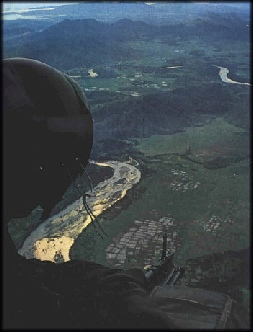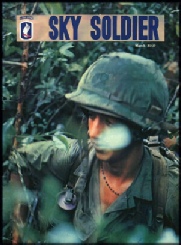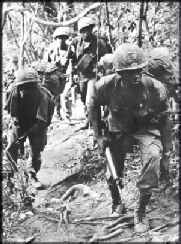Casper aviation platoon Casper Platoon Story

Helicopter Crew Chief
Sky Soldier Magazine, March 1969

 Helicopter Crew Chief
Helicopter Crew Chief
By Sp4 Adrian Acevedo
The man in the flying machine, and one of the
true professionals in the Vietnam War.
Clear left ! Clear right !
247, officially labeled a US Army UH-
Six passengers, including two Red Cross girls and the Brigade Surgeon get off and go about their business at Fire Support Base Shenandoah, temporary headquarters for the 2nd Battalion, 503d Infantry.
Specialist 4 Juan Collazo of Brooklyn, 247's Crew Chief, and Sp4 Pete Penner of Greely, Co, the Door Gunner, meanwhile open the Pilots' doors and slide back the protective armor so the two Warrant Officers can get out.
A tall, thin 21-
It could be almost any type of mission, as 247 is the Command and Control ship for the 2/503d today. "Usually," says Collazo, "its the reserve C&C for the General", but like all the ships in the Casper Platoon of the 173d Airborne Brigade, it can be expected to pull any type of mission on any given day. Collazo keeps 247 in spotless condition, but the same can be said of most Crew Chiefs since they all take tremendous pride in their ships.
Penner and he are standing and talking when a bedraggled Infantryman walks up and asks if the ship is going back to the rear. "Yeah," says Collazo, "but not right away, we have to find out what they want to do with us first. But, we'll be going back sooner or later."
The Infantryman shrugs and sets down his rucksack. "Say," he asks, "weren't you the guys that set down to pick up those two casualties we had a couple of days ago ? We were down in a valley and had snipers up in the hills." "Yeah, that was us," admits Collazo, pleased, as are all Crewmen when they learn the Infantrymen appreciate their efforts. The trooper is a loquacious one, so they continue to chat about life in Vietnam and things in general.
Soon, however, Collazo is checking his ship again, as he is wont to do countless times each day. His diligence is rewarded when he finds a loose knob on the control panel. The Pilots return at this time, so he asks where the control was set at when it came off.
After he screws it in place, the Pilots tell him Delta Company is going to be extracted at 0900 and the Battalion XO will coordinate the move from 247.
They don't take off until 0930 however, because the five extraction ships are late. 247 meets them over the LZ and just circles while they move the Infantrymen six at a time the two clicks back to the fire base. It is cold at the altitude, so Collazo shrugs into a field jacket and stoically waits out the boring hour and a half.
The rest of the day proves to be relatively uneventful. The ship ferries several more loads of passengers back and forth between LZ English and Shenandoah, including the Red Cross girls and a man with a broken arm. They also extract a wounded man from a Mike Strike Force Company working with the Brigade and the body of a Viet Cong killed by Bravo Company which is taken to the Government District Headquarters.
The weather gets progressively worse, however, and the ship has the misfortune to be at the Fire Base when it is no longer possible to fly. The next day, the weather is just as had and the Crew must remain another day at the Fire Base.
On the third day the weather clears, enabling 247 to continue its mission as the 2/503d Command and Control ship. The end of the day finds Collazo, as usual, pulling maintenance on 247.
Of course, these were not topical days for a Helicopter Crew Chief. There are none, which is probably one of the reasons Crew Chiefs like their job so much.
According to Captain Stanley H. Streicher of Cincinnati, Casper's Commanding Officer, several of his Crew Chiefs have flown all day then worked on their ships until it was time for them to pull guard. The next day after only a few hours sleep, they are ready and willing to fly again.
"My Crew Chiefs are a real professional breed of men," declared Streicher. "With their dedication to their ships and their missions and their extremely high morale they've got to be the finest bunch of Crew Chiefs in Vietnam."
Many feel that the Crew Chief is in fact, the most important man in a Helicopter Crew since he is the only one who accompanies the ship evervwhere it goes. The Pilots work with the ships on a rotation basis and the Door Gunners are changed frequently.
"You get to know your ship so well," said Sp5 Bruce Neva of Kensal, ND, "that you can get more out of it than anybody else. After a while, you learn all the tricks about the chopper, so when something goes wrong, you know exactly where to look to fix it."
There is an intense rivalry among the Casper Crew Chiefs as to who has the best ship. "I have the best ship," declared Neva, who waxes his Slick daily. But, there are others who quickly dispute Neva's statement as they all spend countless hours in maintenance to keep their choppers in top condition. As Neva explained, "You have to like flying and you have to like working on your ship to be a good Crew Chief."
Aids the Pilot
While in flight, the Crew Chief's main job is to aid the Pilot in navigating by keeping him informed of approaching aircraft and obstacles on landings and takeoffs. He also supervises the loading when the ship is carrying personnel or supplies to insure that it won't be so heavy as to seriously damage the aircraft.
When air assaulting Infantrymen into unsecure territory, it is also his job to signal the men when it is time to leave the ship. And of course, both he and the Door Gunner handle the M-
In addition to these qualities, a man has to have an extra amount of courage to fly Crew Chief on an OH-
The OH-
On one mission, Bravo and Charlie Companies of the 2nd Battalion were receiving heavy sniper fire from a woodline between their positions. They couldn't reach the enemy, so a Loach was called in to silence the snipers. In addition to firing the minigun, Sp5 Rick Canning of Memphis, Tn, was so effective at tossing out grenades, the Infantrymen asked later if the ship was armed with rockets. "Nope," replied the Pilot, "that was just my Crew Chief doing his job."
Love Loaches
Loach Crew Chiefs have as much pride in their ships as those on Slicks. "I guess I just like the way a Loach flys low and can sneak up on Charlie," said Sp5 Mike Nuckols of Red Bluff, Ca "I remember one time when we caught one in the open. He started to run, but there wasn't any place to hide, so we just set down and I motioned him into the ship with a .45. He turned out to be the son of a Viet Cong district chief.
On a similar mission, Canning's ship and another Loach were supporting armored vehicles which had trapped a VC force against a large lake south of LZ Uplift. Several of the enemy had boarded boats and were trying to escape across the lake.
The Loaches just knocked the two boats over with their rotor blast and made the VC hang on to their skids while they ferried them one at a time to friendly forces waiting on shore.
Another type of Crew Chief just as dedicated as those in Casper are the men who crew the Gunships for 61st Assault Helicopter Company, which supports the Brigade out of LZ English.
Sp5 Don Casella of Burbank, Calif., explained that the 61st's UH-
"The maintenance is much more complicated on a Gunship than on a Slick," he said. "The Crew Chief has to know the whole armament system, and it's a dual hydraulic system instead of the single one the Slick has. It is just a completely different ship with a lot more maintenance."
"Despite the extra work," continued Casella, "I prefer crewing a Gunny to a Slick. Just guess I'd rather do the shooting than get shot at."
As on a Loach, the Gunship Crew Chief mans an M-
Most Crew Chiefs are young and are serving their first tours in the Army, but their bravery, dedication and ability to handle an emergency has proven beyond all doubt their worth in Vietnam.
In one instance, Sp4 Gary Poland of Sayreville, ND, a Loach Crew Chief from D Troop 2/lst Cavalry, working with the 1st battalion, grabbed the ship's controls when the Pilot was hit by enemy fire and blacked out. Poland pulled the ship out of a dive and continued to fly it until the Pilot recovered consciousness and was able to make a forced landing.
Asked later how he did it, Poland who had never had any flight training, grinned, "It really wasn't that hard. I've spent a lot of time watching the Pilot fly."
Maybe it really wasn't that hard, but, there aren't too many people who could have done it. Except perhaps another Crew Chief.
(Reprinted)

Contents
Volume 2, Number 3
March 1969


This site was last updated: 2/15/15
